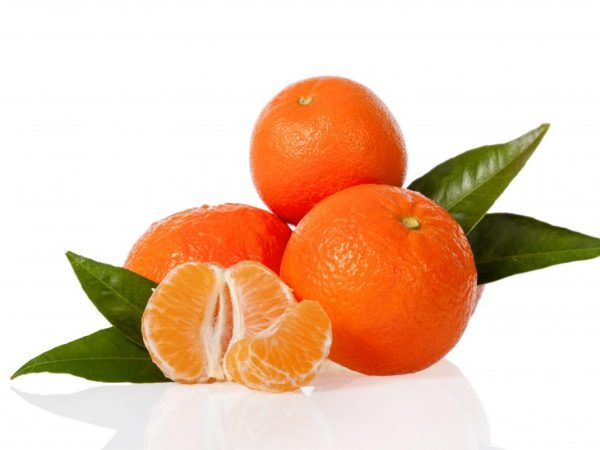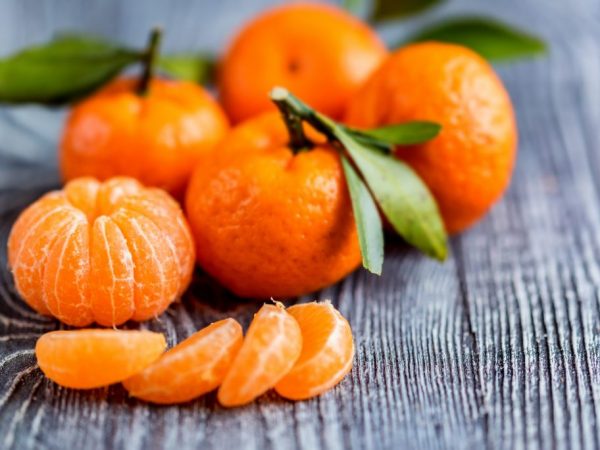Moroccan tangerines
There are many types of tangerines. Moroccan mandarins are easily recognizable by special black diamond-shaped stickers. Studying the characteristics of the fruit will allow you to choose them correctly and enjoy the taste.

Moroccan tangerines
Characteristics of the variety
Mandarins from Morocco have a porous skin with a uniform color. Moroccan tangerines should be weighty, have a good density, such fruits will be sweet. You should not take dry fruits.
Description of the bush
Moroccan tangerines are an evergreen tree that grows to a height of about 4-5 m, its yield is 5-7 thousand fruits.
The crown of the tree is rounded, spreads out, reaching 3.5 m in diameter. The bark of the tree is light gray in color, the shoots are dark green. Mandarin has small, leathery leaves with sharp ends, they have the shape of an egg, their color remains unchanged at any time of the year.
The flowering period of the tree is from April to early summer. There are single and paired flowers that are located in the axils of the leaves. They smell good, smell like bergamot.
Description of fruits
Fruits should be firm, have the correct shape, and come in light yellow to orange shades. The pulp of Moroccan fruits has few seeds and is juicy. The taste is sweet and sour, the sweetness prevails over the acid. Fruits grow up to 4-6 cm in diameter, include 10-12 lobules. The yellow-orange pulp consists of sacs containing juice.
Fruit selection rules
It will be possible to distinguish ripe Moroccan tangerines from unripe and spoiled if you follow the rules for checking and studying their external features:
- the fruit began to rot if juice flows out of it with a little pressure;
- when the tangerines are ripe, their skin is easily peeled off;
- fruits with spots, mold cannot be eaten;
- if the fruit has dents, they are frozen or begin to rot;
- dry peel of the fruit indicates their poor quality;
- the size of the fruit determines their taste: large, most often sour;
- the sweetest taste is in medium-sized fruits with a bright orange skin;
- yellow dense fruits are sweet.
Growing
The fruits are self-pollinated. The first harvest is obtained 3-4 years after planting. In early spring, the first shoots grow, the second in mid-August. Fruits are formed on the last year's second growth or the first of the current year.
Ripening of Moroccan fruits takes place in October, in December they are harvested. The growth and formation of fruits occurs in 7 months.
Care
Taking care of the tree is especially important during flowering and fruit development. Leaving involves an increase in phosphorus-potassium supplements, a decrease in nitrogen.
The tree independently regulates the number of ovaries and removes excess ones by dropping. Normal load is 1 fruit per 15-20 leaves, others are removed.
Fruits are prone to cracking if irregular watering is carried out, a large amount of nitrogen has accumulated in the soil.
Diseases and pests

Tangerines need care
Moroccan mandarins, like Abkhazian ones, are susceptible to diseases and pests. Their development is influenced by the conditions in which fruits are grown:
- dry or humid air;
- imbalance of trace elements in the soil.
Diseases of mandarins:
- Anthracnose. All parts of the tree are affected, the foliage turns yellow and falls off, the bark loses its shape, the skin becomes covered with red spots, this leads to rotting.
- Hommoz. The disease manifests itself as red-rusty spots, on which cracks in the bark appear, and gum appears from the cracks.
- Wart (scab). Foliage, shoots, fruits are affected. It manifests itself in the form of translucent gray-pink spots. The ovaries dry, fall off, the fruit becomes brown, the peel is brown, with tubercles.
Moroccan fruit pests:
- Spider mite. It affects the leaves, envelops them with cobwebs, as a result, they curl.
- Shield. Dangerous for fruits in the cold season. The lower leaf blades, branches suffer, and discharge appears on the tree.
Fight disease
In the fight against anthracnose, "Fitosporin" helps, the infected parts of the tree are removed. The disease develops due to the burrowing of the seedling into the ground, its damage, an excess of nitrogen and a lack of potassium-phosphorus fertilizers.
If gommosis appears on the fruits, the cracks are protected from gum, they are treated with copper sulfate, and the wounds are covered with garden varnish on top.
A 1% Bordeaux solution helps to fight scab, spraying is repeated 3 times.
Pest control
When a spider mite is detected, a shower is used: the foliage is doused with either cold or water at a temperature of 40 ° C, watering is repeated 2-4 times. Pests are removed in parallel with a toothbrush, the soil is covered with ash. After 11-12 days, the treatment is repeated. In severe cases, use drugs "Fitoferm" or "Actellik".
Soap solution helps to fight the shield. To prepare it, 20 g of soap is diluted in 3 liters of water, the leaves are treated with a solution and left for half an hour, then washed off. If the pest has seriously settled on the tree, use "Fitoferm" or "Actellik". At the initial stage of detecting parasites, washing with garlic or onion broth is used.
Conclusion
Moroccan tangerines have a pleasant taste. It will turn out to choose juicy fruits and enjoy their use after studying the rules of agricultural technology and the characteristics of fruits.

